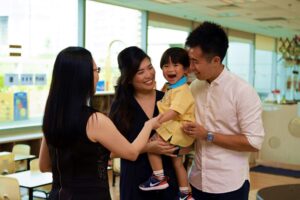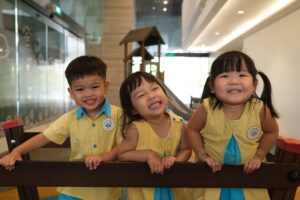BACK
4 Curriculum Models Top Preschools Use
Choosing the right preschool for your child is a big step for parents. With many options available, understanding the different curriculum models can help you make an informed choice.
Preschools often adopt various approaches to early childhood education, each with its unique philosophy and methodology. Let’s explore five prominent curriculum models used by top preschools in Singapore and the benefits they offer.
Play-based Learning
Play-based learning is a widely recognised method of early childhood education that emphasises the importance of play in a child’s development. Children are led to explore, experiment, and create in a hands-on environment in play-based preschools.
The activities are crafted to be enjoyable and captivating, enabling children to learn by tapping into their innate curiosity and interests.
Benefits:
- Promotes creativity: Play-based learning fosters creativity and imagination as children engage in open-ended activities where there are no right or wrong answers.
- Develops social skills: Through play, children learn to interact with their peers, negotiate, and collaborate, developing essential social skills.
- Encourages problem-solving: Play-based activities often challenge children to overcome, promoting problem-solving skills and critical thinking.
- Supports emotional development: Play provides a secure environment for children to express their emotions, cultivating emotional resilience and self-regulation.
Montessori
The Montessori approach to early childhood education, developed by Dr. Maria Montessori, is based on the principles of independence, freedom within limits, and respect for the child’s natural development.
Montessori preschools provide a prepared environment where children can learn independently.
Benefits:
- Promotes independence: Montessori classrooms are designed for children to make choices and take ownership of their learning, promoting independence and self-confidence.
- Hands-on learning: Montessori materials are carefully put together to facilitate hands-on exploration and sensory experiences, helping children develop a concrete understanding of abstract concepts.
- Focus on practical life skills: Montessori education emphasises developing practical life skills such as pouring, dressing, and cleaning, fostering independence and self-care.
- Child-centred approach: Montessori teachers serve as guides rather than lecturers, observing and supporting each child’s interests and abilities.
Reggio Emilia
Reggio Emilia is a curriculum model that originated in Reggio Emilia, Italy. This approach views children as competent individuals actively participating in their learning.
Reggio Emilia preschools emphasize the importance of the environment, documentation, and collaboration in the learning process.
Benefits:
- Child-led learning: In Reggio Emilia preschools, the curriculum emerges from the children’s interests and inquiries, allowing authentic and meaningful learning experiences.
- Emphasis on the arts: Reggio Emilia schools weave the arts into all aspects of the curriculum, providing children with multiple outlets to express themselves and communicate their ideas.
- Strong community connections: Reggio Emilia preschools often involve families and the local community in learning, creating a sense of belonging and shared responsibility for children’s education.
- Focus on documentation: Teachers in Reggio Emilia schools document children’s learning through photographs, videos, and written observations, creating a rich record of their experiences and progress.
Waldorf Steiner
Rudolf Steiner developed the Waldorf Steiner approach to early childhood education based on his philosophy of anthroposophy. This philosophy emphasises the spiritual nature of the human being and the importance of holistic education.
Waldorf Steiner preschools provide a nurturing environment that fosters imagination, creativity, and a deep connection to nature.
Benefits:
- Holistic education: Waldorf Steiner education addresses the intellectual, emotional, and spiritual dimensions of the child, aiming to cultivate a lifelong love of learning and a sense of purpose.
- Emphasis on play and imagination: Waldorf Steiner preschools prioritise free play, storytelling, and imaginative activities, allowing children to engage with the world in a meaningful and creative way.
- Integration of arts and academics: Arts such as music, painting, and handwork are integrated into all aspects of the curriculum, providing multiple entry points for learning and self-expression.
- Connection to nature: Waldorf Steiner schools often have outdoor classrooms and nature-based activities, fostering a deep appreciation for the natural world and ecological stewardship.
Integrated and Bilingual Curriculum at Little Skool-House
At Little Skool-House, we incorporate a variety of approaches, taking the best out of the different curriculums and incorporating them into our school. We integrate learning across six subject domains: Language & Literacy, Maths, Science, Creativity, Physical Self and Social Development.
Our goal is to support your child in becoming who they are meant to be by nurturing their interests, feeding their natural gifts and giving them the confidence to grow academically, physically, mentally and socially.
We also cater to local needs. In Singapore, it is important to find a preschool that emphasises bilingualism. As a SPARK-certified top preschool in Singapore, Little Skool-House nurtures confident, bilingual learners who are well-prepared for the challenges of primary school and beyond.
Our curriculum framework is designed to ignite your child’s curiosity, foster a love for learning, and prepare them for a successful journey ahead. With science-backed methodologies and a commitment to building solid foundations, we ensure that every child at Little Skool-House receives the support and guidance they need to thrive academically and beyond.



